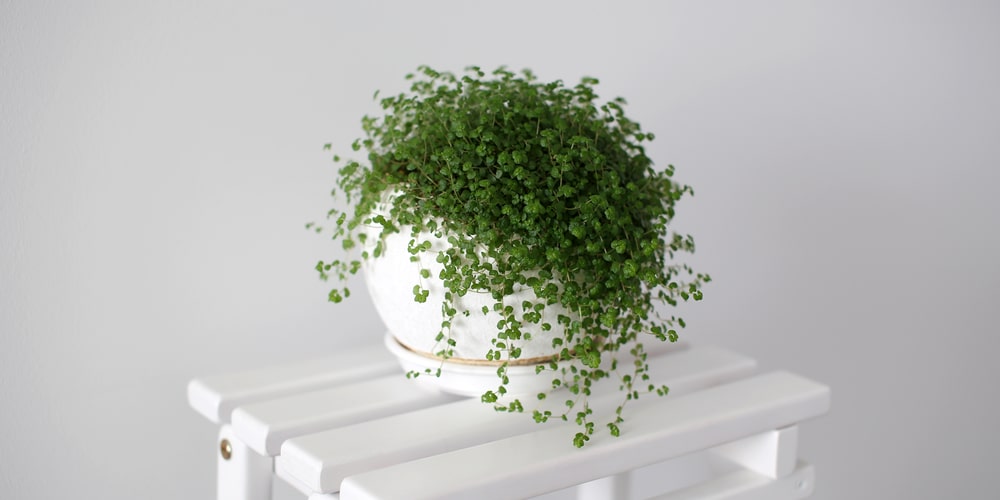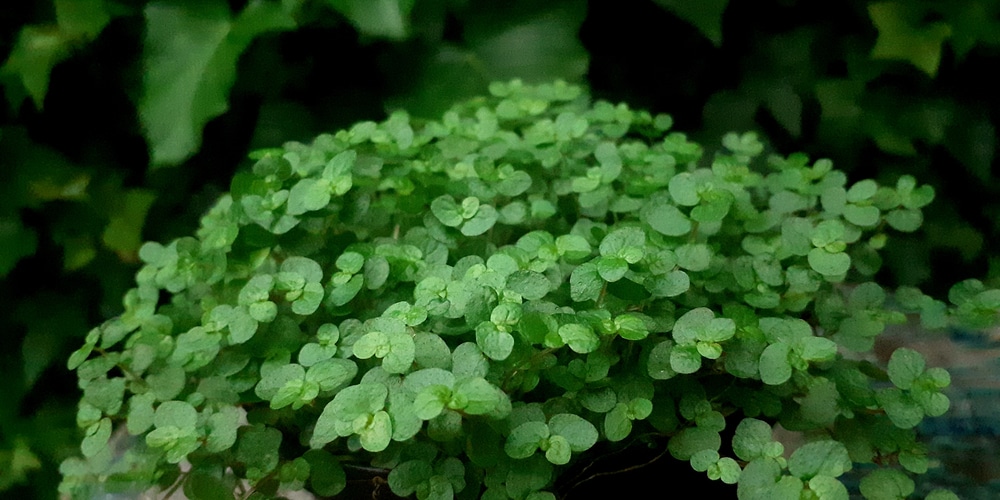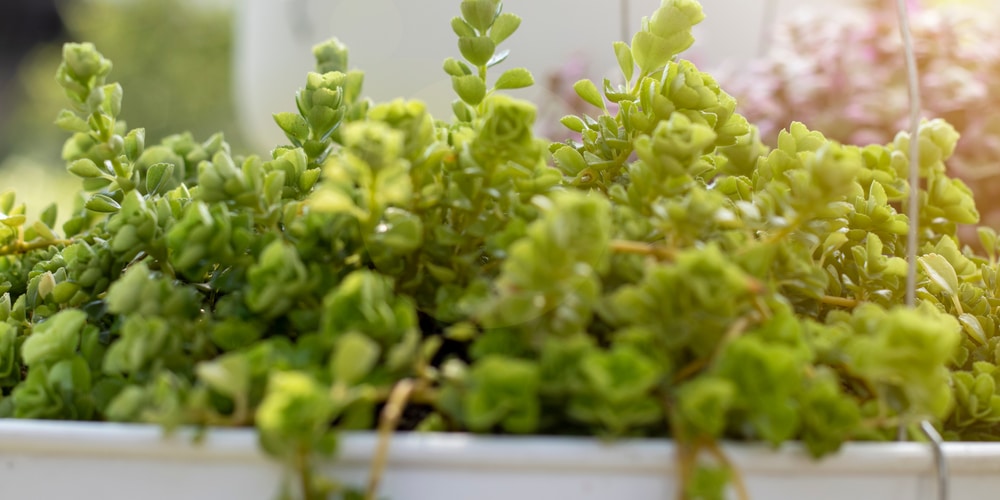Baby Tears plants thrive in shady, wet places. So, they usually share the soil with ferns and hostas. But as this plant’s numerous names suggest, once it gets into your lawn, it spreads and spreads, taking over your land.
This species is the ultimate creeping, mat-forming plant that the Victorian elite introduced to the world and now softens the edges of many gardens on almost all continents.
Botanical Name: Soleirolia soleirolii (previously known as Helxine soleirolii)
Common Name: Angel’s Tears, Baby Tears, Corsican Carpet, Irish Moss, Mind Your Own Business, Paddys Wig, Pollyanna Vine
Plant Type Perennial
Flower Color Pink and white
Size When Mature 4 inches (height), 40 inches (width)
Bloom Time Late Spring/Early Summer (May, June)
Sun Requirements Full or Partial Sun
USDA Hardiness Zones 9-11
Soil PH Range 5-6
Soil Type Loamy, Moist, Slightly Acidic
Water Needs Medium/High
Native Area Sardinia, Corsica, Italy
What you Need to Know About Baby Tears
Baby Tears is a frost-tender groundcover plant that prefers shade to full sun. Thanks to its tiny rounded leaves, its green foliage helps more exotic plants blend in your garden.
It grows well at the base of tree ferns or against a brick wall. Or next to ponds and stone boulders. This evergreen is easy to care for because it stays pretty small and compact.
The groundcovery mat still allows bigger plants to push through because the Corsican carpet will not grow taller than 4 inches. More importantly, it is a pet-safe plant even though it belongs to the Urticaceae family—the nettle family.
Even though it is called Irish moss, this plant does not produce any stinking smell. It usually blooms during May and June and makes lovely tiny pink and white flowers that only add more beauty to its gorgeous aesthetics.
This plant is also a bee’s favorite. Indeed, the only downside is that it might be hard to remove once it settles in your garden.
How to Care for Soleirolia Soleirolii
Here’s everything you need to know about growing and caring for a thriving Baby Tears
Light
With low light conditions, Baby Tears grows slowly. Optimal lighting for explosive growth would include two hours of direct morning light and medium to bright indirect light for the rest of the day. Full sun can lead to sunburned foliage depending on the humidity.
Rotating potted vines like Paddys Wig every two weeks is necessary to achieve a fuller look. Otherwise, the plant will dangle from just one side. Do not rotate the pot completely, though! This plant does not grow tall, so it needs time to adjust and send out new shoots.
Water and Soil Needs
Angel’s Tears plants love neutral to slightly acidic (within the pH range 5.0-6.0), humus-rich, moist, well-draining soil, and humid places. So, you can place it in your bathroom if you want to grow it in a container.
As long as you do not let your Baby Tears dry out completely, this plant will keep spreading anywhere it can grow. For clarity, its water needs will depend on the space you have in mind for it to grow into and your climate.
It will thrive both in the shady borders or in an indoor container, provided that the soil is moist yet well-draining. But the irrigation water needs in hot climates like California will be high.
When repotting this plant, you can place use all-purpose potting soil. But if you add some perlite in it—an 80/20 mix of potting soil and perlite—you will improve the soil aeration and drainage, and your vine will love it.
Temperature Requirements
Baby Tears plants grow best in areas with high humidity levels. What is more, they do not tolerate cold and frost. So, the more appropriate USDA zones are zones 9 through 11.
Temperature-wise, the vine will survive to temperatures as low as 14F. Of course, Soleirolia soleirolii dies in winter and comes back in spring.
As soon as the temperature rises above 50F, the plant’s water needs increase rapidly, especially during the vegetative and flowering stages, between May and June.
Lastly, seeing pinkish flowers on the Pollyanna vine lasting until fall in hot climates is not uncommon.
Fertilizer
If you repot your Baby Tears once a year, you probably do not need to fertilize your plant. But if you want to, the best fertilizer to use on a Baby Tears is worm casting.
Of course, you can just buy worm eggs and release them in your garden if you plant them as a groundcover.
A 20-10-5 slow-releasing granular fertilizer also works well unless you put the plant in a self-watering pot.
Common Diseases
In theory, high humidity can promote fungal infections. And overwatering will definitely cause root rot. But in general, Baby Tears is a resilient vine with virtually no diseases.
Helxine Propagation
Soleirolia soleirolii propagates incredibly easily. In brief, the vine will grow roots wherever soil touches the stems.
You can either propagate a Baby Tears plant by division or stem cutting. If your potted plant has filled its container, the former is highly recommendable. On the other hand, you might find it easier and less stressful for the plant to cut a couple of longer stems if your vine is still young.
To divide your Angel’s Tears, follow these simple steps:
- Prepare a tray with a 50/50 mix of peat and perlite or the new container and fill it with loose potting soil.
- Take the Baby Tears out of its pot and inspect the roots for signs of fungal infections. Discard any suspicious-looking mold sitting in damp soil clusters to be sure.
- Pull apart a group of stems from the edges. As a rule of thumb, look for established clumps—small plants that originated from the central part of the plant.
- Put the divided plant in the medium and repeat.
- Dissect the main vine from the edges into manageable sections. Usually, the roots will resist your pulling action. And although some stems may die, the clusters you make will survive and thrive in the new location.
- Moisten the soil with water and place a plastic dome over the plants to keep humidity high, at least for a day, and help them adapt to the new home.
Related Article: Drought Resistant Flowers for Colorado Yards


